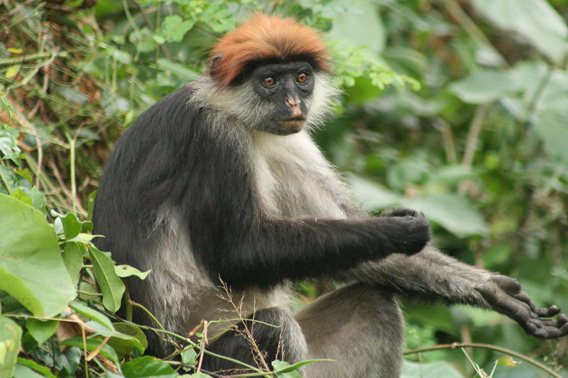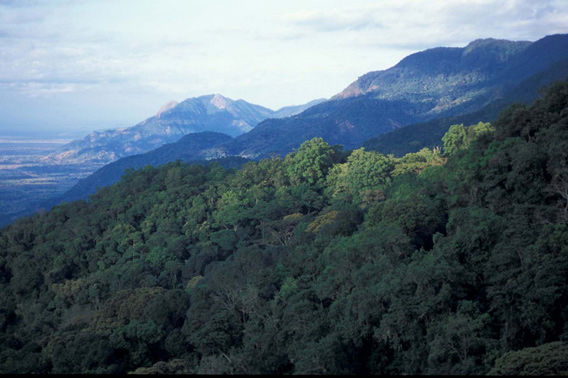
Udzungwa red colobus. Photo: (c) Photo by Thomas Struhsaker.
Hunters are decimating species in the Udzungwa Scarp Forest Reserve, a part of the Eastern Arc Mountains in Southern Tanzania, according to a new report compiled by international and Tanzanian conservationists. Incorporating three research projects, the report finds that bushmeat hunting in conjunction with forest degradation imperils the ecology of the protected area.
“Some species in this region are on the brink of extinction from one of their last remaining strongholds, especially the Udzungwa red colobus, a monkey species found only in these mountains and nowhere else in the world,” said Arafat Mtui, Udzungwa Ecological Monitoring Center coordinator, in a press release.
The report also finds that duikers, a small antelope, are in danger of vanishing from the forest due to hunting, and that the Angolan colobus may already have disappeared from the forest. Historically, hunting and other human impacts have long taken a toll on the forest: wiping out elephant, African buffalo, leopard, and bush pig.
“The Udzungwas [Mountains] are the pearl of the Eastern Arc Mountains because they contain the largest forests and have extraordinary numbers of plant and animal species found nowhere else on earth, including two species of monkeys,” stated Francesco Rovero of the Trento Museum of Natural Sciences, who led the preparation of the report. “Unfortunately, while some of the forests are protected by the Udzungwa Mountains National Park, there are important forests such as Uzungwa Scarp Forest Reserve that have not been granted adequate protection.”
The researchers recommend that immediate steps are taken to halt the decline of the forest’s rare species, including stepping-up law enforcement efforts and forest patrols; providing opportunities for local communities to get involved in managing the forest; and environmental education for locals. The researchers further recommend that the government of Tanzania should upgrade the area’s protected status to ‘Nature Reserve’.
“The government needs to allocate the resources that are required to manage this national treasure and to address the needs of the adjacent communities,” Charles Meshack,
Executive Director of the Tanzania Forest Conservation Group, said.
A biological hotspot, the Eastern Arc Mountains are home to some 100 unique animal species and 850 unique plants. In a recent list by Conservation International (CI) Africa’s mountain forests, including the Eastern Arc, were listed as number 10 in the world’s top 10 most threatened forests.

The Uzungwa Scarp Forest Reserve in southern Tanzania. Photo (c) by Rovero Francesco.
Related articles
Africa’s vanishing wild: mammal populations cut in half
 (01/27/2011) The big mammals for which Africa is so famous are vanishing in staggering numbers. According to a study published last year: Africa’s large mammal populations have dropped by 59% in just 40 years. But what is even more alarming was that the study only looked at mammal populations residing in parks and wildlife areas, i.e. lands that are, at least on paper, under governmental protection. Surveying 78 protected areas for 69 species, the study included global favorites such as the African elephant, giraffes, zebra, wildebeest, and even Africa’s feline king, the lion. “We weren’t surprised that populations had dropped but we were surprised by how large the drops had been,” lead author Ian Craigie told mongabay.com in an interview.
(01/27/2011) The big mammals for which Africa is so famous are vanishing in staggering numbers. According to a study published last year: Africa’s large mammal populations have dropped by 59% in just 40 years. But what is even more alarming was that the study only looked at mammal populations residing in parks and wildlife areas, i.e. lands that are, at least on paper, under governmental protection. Surveying 78 protected areas for 69 species, the study included global favorites such as the African elephant, giraffes, zebra, wildebeest, and even Africa’s feline king, the lion. “We weren’t surprised that populations had dropped but we were surprised by how large the drops had been,” lead author Ian Craigie told mongabay.com in an interview.
Bushmeat hunting alters forest structure in Africa
(11/04/2010) According to the first study of its kind in Africa, bushmeat hunting impacts African rainforests by wiping-out large mammals and birds—such as forest elephants, primates, and hornbills—that are critical for dispersing certain tree species. The study, published in Biotropica, found that heavy bushmeat hunting in the Central African Republic changes the structure of forest species by favoring small-seeded trees over large-seeded, leading to lower tree diversity of trees that have big seeds.
Photos: three new forest frogs discovered in Tanzania
(10/19/2010) Africa’s most biodiverse nation, Tanzania, has added a few more species to its dockets. Researchers have discovered three new amphibians in the always surprising Eastern Arc Mountains, a region which has supplied a number of new species recently. All three new species are members of the frog genus Callulina. Described in the Zoological Journal of the Linnean Society the researchers warn that all three of the new frogs are confined to small habitats threatened by deforestation and firewood collection.